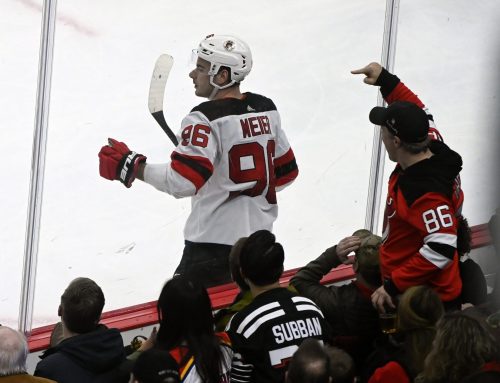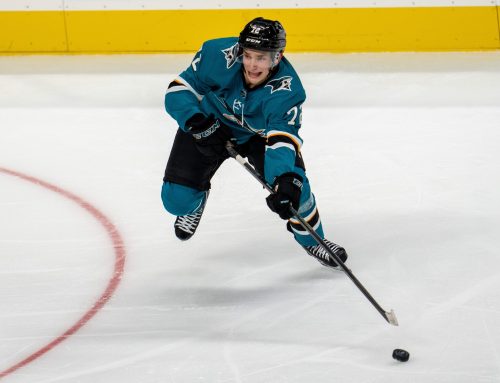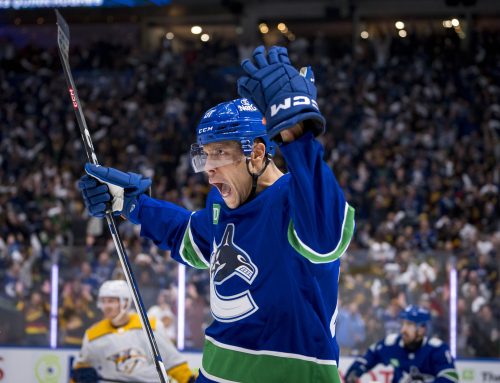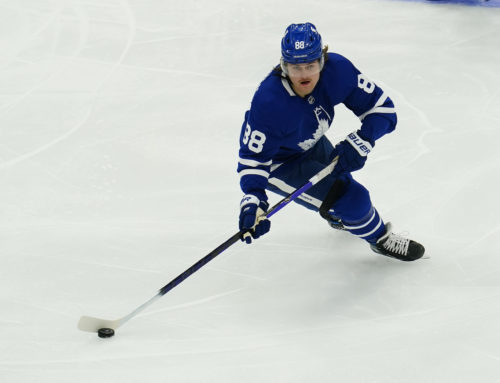Ramblings: Vasilevskiy extended; Devils trade for Gusev; roster battles – July 30
Michael Clifford
2019-07-30

We had two big bits of news on Monday.
First, the Lightning extended goalie Andrei Vasilevskiy for eight years with an average annual value of $9.5M. The deal kicks in for his age-26 season, after his current contract expires following the 2019-20 campaign.
In that sense, this deal kind of stands alone. Sergei Bobrovsky got a monster off-season contract, but he turns 31 in September. Carey Price also turned 31 for the first year of his $84-million contract. Henrik Lundqvist’s current deal kicked in when he was 32.
The best comparable we have is probably Tuukka Rask, who’s current eight-year deal started when he was 26. It’s seemingly turned out alright for the Bruins, though they got a bunch of superstars for what would end up being well below market value deals. They’ve had to finagle around the cap even with those savings, partly because they were committing nearly $10M in net at times.
If there is a goaltender that has earned this type of contract, it’s Vasilevskiy, though whether this is worth the price in a cap league is up for debate. Fantasy rosters with a pending cap crunch would do well to trade Vasy now, I think.
*
The second bit of news was that the Devils continued their stellar offseason by acquiring winger Nikita Gusev from the Golden Kngihts for a second- and third-round pick. New Jersey then signed Gusev to a two-year deal with a $4.5M AAV.
You can read Dobber’s take on Gusev in New Jersey here.
One area I disagree with Dobber is how the top PP configures. I have Palmieri-Hall-Hischier-Gusev with Subban on the blueline and Jack Hughes on PP2. Over the last four years, Palmieri has more PP goals than: Vladimir Tarasenko, Patrick Kane, Joe Pavelski, John Tavares, and Sean Monahan, and the same number of PP goals as Tyler Seguin. He’s 1 of 12 players with more than 40 PPGs over those four seasons, and he’s just 28 years old. He’s the team’s best goal scorer, regardless of strength. Maybe I’m wrong here but it seems like that kind of goal scorer should never be left out of prime PP minutes.
Regardless, there is some serious offensive upside for a team that needed it. If Gusev works out as we hope, this is a roster with two very threatening scoring lines, and some good depth pieces like Miles Wood and Blake Coleman. The Metro looks wide open this year and the Devils will figure into the mix heavily.
*
The time has almost arrived as it’s just two more days until the 2019-20 Dobber Hockey Fantasy Guide is released. It has everything that the savvy fantasy owner needs to succeed in their fantasy leagues from rankings and depth charts, to prospects and projections, to breakouts and other articles. It is also updated all throughout training camp. Be sure to head to the Dobber Shop and pre-order your copy today!
*
One thing I’ve started doing is putting together what I think depth charts will look like in October. But I wanted to talk about line combinations in general first.
Over the weekend, I took a look at line combinations from year to year across the league. I knew that in seasons long ago – we’re talking roughly a decade – teams didn’t change their line combinations as often as they do now. It probably looks easier in a graph, so here are the number of line combinations in the league per season in the Behind The Net era, or since 2007-2008, with at least 50 minutes played at five-on-five (data from Corsica):

Things have stabilized over the last few years after a lot of movement five years ago and beyond. When we consider that the league introduced a new team for the last couple seasons, the rate of line combinations per team is actually declining a little.
This isn’t overly important except to show that the NHL isn’t really getting more chaotic in terms of line combinations. My intuition, mostly borne from playing DFS, was that line combinations had skyrocketed in the last few years. That is not the case.
Anyway, that was just a brief aside how sometimes our intuition is wrong and to always double-check what we think we know. There’s a quote mis-attributed to Mark Twain (the actual author is still unknown, as far as my research can tell) at the start of the movie The Big Short, and despite the mis-attribution, it is very important to keep in mind for fantasy sports:
It ain’t what you don’t know that gets you in trouble, it’s what you know for sure that just ain’t so.
Always double-check what you know for sure.
To get back to the original point, line combinations and roster spots that will be of importance this season. I’m going to skip Colorado’s power play because that will be a focal point for a lot of people this off-season and will be discussed ad nauseum.
Vancouver’s PPQB
When I did my projections a couple weeks ago, I split the top power-play minutes among all three of Alex Edler, Tyler Myers, and Quinn Hughes. Not equally, mind you, but by percentage it was a 50/30/20 split, respectively. The basic assumption is that Edler starts on the top PP unit but when his injury history inevitably catches up with him, Myers will be the guy to replace him, with Hughes eventually taking over later in the year.
Of course, this is mostly guesswork based off assumptions in the last week of July. Should we get indications at some point during training camp that Edler won’t be on the power play, or Hughes gets a straight shot to the top unit, these projections will change drastically.
Before scoffing at the idea of Edler on the top PP unit, keep in mind that Vancouver’s power play was really good with Edler last year: the team scored 9.4 goals per 60 minutes at 5v4 with Edler and Elias Pettersson on the ice in 2018-19. For reference, the Bruins had the second-highest goal rate last year at 5v4 with 9.2 goals per 60 minutes. With those two off the ice, or playing apart, the team generated far fewer shots and goals with the man advantage.
Now, that’s partly due to the lack of scoring depth, and thus the lack of PP2 options for a good second unit, but it would be foolish to switch up the PPQB for a unit that had so much success. If they flounder out of the gate and don’t turn it around, then that’s another story.
Dallas Second Line Right Wing
The signing of Joe Pavelski now gives the Stars the ability to do something they haven’t been able to do basically since acquiring Tyler Seguin: give them dual threats on their top two lines. There were some guys who’ve helped, like Mats Zuccarello, but none were a long-term option. Now, with Pavelski, the team can run duos of something like Seguin-Radulov and Benn-Pavelski, fill in the winger spots with depth options, and now they have a threatening second line.
Let’s assume they run a top line of something like Hintz-Seguin-Radulov. The assumption seems to be, then, that Corey Perry would line up on the second line with Benn and Pavelski. That worries me.
Benn is a 30-year old power forward who really hasn’t looked the same since his hip and core surgeries. The latter came in 2016, and 2016-17 was a bad year. Sure, he still had 69 points, but his ice time declined, his shots per minute declined (and still haven’t rebounded, three years later), and the two worst 82-game seasons of his career by Evolving Hockey’s goals above replacement (GAR) have been in the last three years. Expecting Benn to be the player he was five years ago is a mistake.
Of course, Benn is still a good player. Benn’s 2018-19, which, by the GAR mentioned above was the second-worst of his career, was better than any of Perry’s last four years. Let me repeat that: Benn, who appears to be in decline and posted one of his worst seasons in 2018-19, was still better in 2018-19 than Perry has been at any point in the last four years. And that holds true if we do total GAR or GAR per 60 minutes, meaning games played isn’t an issue either. Now, does Perry bounce back from all the injuries he’s endured himself? That’s a tough bet to make at the age of 34, and the only reason to pencil in Perry as the RW2 right now is because of a lack of options pushing him, not because he’ll play up to that level. Even with that, I have Perry pencilled in for just 50 percent of his even strength ice time in the top-6 because I do feel his career his coming to a close. What say you?
Anaheim Top Line Right Wing
Looking at Anaheim’s lineup, there are a lot of pieces to like. Rickard Rakell and Ryan Getzlaf are both solid bounce back candidates, Ondrej Kase should be in for a nice rebound following his injury-plagued season, John Gibson is a great goaltender, Jakbo Silfverberg is usually good for a sneaky 20 goals, Adam Henrique could be a solid PP producer, and there are some solid prospects like Troy Terry and Sam Steel.
But then I work out the line combinations and it’s a bit of a mess. Let’s work through an exercise.
Let’s say the top line is what many of us expect: Rakell-Getzlaf-Kase. That would certainly be a formidable trio at the top of the roster. But what does that leave for the rest of the lineup? What about…
Eaves-Henrique-Silfverberg
Comtois-Steel-Terry
Sherwood-Grant-Sprong
This assumes Patrick Eaves is back, which is not a sure thing. It also assumes that all three of Comtois, Steel, and Terry make the team out of camp. But now we see where the issues crop up.
Does Dallas Eakins go with what is effectively an all-rookie third line? Probably not. So, move Terry up to play with Eaves and Henrique? Seems like a waste of Terry’s play-making talents. Move Terry to the fourth line, which is similarly a waste of his play-making talents? Maybe switch Eaves and Comtois?
And this precludes guys like Nick Ritchie and Devin Shore from even being in the lineup. If Shore is in the lineup, he likely displaces a centre. It won’t be Getzlaf or Henrique, and Grant has a one-way deal so if they want both Shore and Steel in the lineup, Grant would need to go on waivers. Ritchie could take Eaves’ spot if he’s not up to the level the team needs him in October.
Let’s say Ritchie takes Eaves’s spot in the lineup and Shore is the third-line center. We get something like this:
Ritchie-Henrique-Silfverberg
Comtois-Shore-Terry
Sherwood-Steel-Sprong
This would (likely) mean waivers for Grant and Eaves in the press box in order to get Shore, Ritchie, and the three kids in the lineup. But we’ve also forgotten a couple others: what about Nic Deslauriers and Carter Rowney? Seems like a couple more candidates for the press box, but it also means they’ll figure into games at some point. Leaving Kase on the top line likely means the team has a pretty bad third line, or at the very least an unproven one.
What I’m trying to get at here is a couple things:
- I’m not convinced that Kase spends the majority of his 5v5 time on the top line
- I’m not convinced that all three of Comtois, Terry, and Steel make the team out of camp. Terry is still exempt from waivers, by the way.
We’ve run out of NHL roster spots and still haven’t even considered other young guys who could push for a spot like Max Jones and Isac Lundestrom.
This is an exercise to point out what a mess this Anaheim lineup is going to be this year. Beyond the duo of Rakell-Getzlaf, I’m not sure there are other pairs of players we’ll see stick together – maybe Henrique-Silfverberg?
What do you guys think? Are the Dobber readers expecting Kase sticking on the top line all year? What about the roles for the kids? Hit us up in the comments.





 TOR
TOR BOS
BOS DAL
DAL VGK
VGK EDM
EDM L.A
L.A COL
COL FLA
FLA T.B
T.B VAN
VAN WPG
WPG NYR
NYR BUF
BUF
